Sunday January 14th 2002
Left Jesus Pobre at 10.15 am Sunday morning on a six day trip to Marbella.
We are not including secondary information about the Costa del Sol as we are unlikely to spend further holidays in the Marbella and Malaga area
Taking our normal E15/A7 we headed for Murcia and just before Murcia took the E15/N340 to Almeria/Granada Mileage 164 km time 11.45 a.m.
Stopped for Coffee in Puerto Lumbreras. Did not like the look of The Parador but found a small restaurant Meson Villarejo at the far end of the town on the right. Looked as if it could be very nice for a meal – but too early. Then kept going and rejoined the motorway.
Came off C3327 to Vera past Huercal Overa – Exit 534. This is a fruit growing area with greenhouses and lots of plastic covering. Through Garrucha – a built up holiday apartment area with rows and rows of homes by the sea. Turned up to Mojacar which from a distance shimmers like the mirage of a Moorish citadel, its white houses cascading over a loft ridge near to the sea. The village was taken by the Christians in 1488 and the Moors were later expelled. In the years after the Spanish Civiil War the village fell into ruin, as much of its population emigrated. In the 1960’s Mojacar was discovered by tourists, giving rise to a new era of prosperity. The old gateway in the walls is still here, but otherwise the village has been completely rebuilt. Suggested eating spot the El Rincon de Embruya a local snack bar with many local specialities – Meal for two 2450 pesetas (€14.80 Euros). Total mileage to Mojacar 326 km
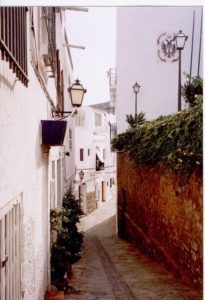
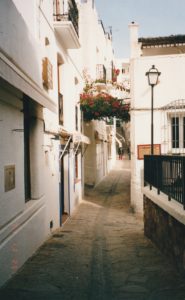
Returned back down to the sea and on to Carboneras – carry along through town, don’t turn inland. Don’t loose heart past dockland area and new decalination plant – Carry on into Park Natural past Playa de los Muertos – over rugged hillside to arrive at Agua Amargo and the Hostel Familia at 3.35 p.m. Mileage 361 km
Agua Amargo is a little fishing village worth visiting and would suggest later in the year and not January – The Hostel Familia is run by a French couple Rather basic hostel but had a very good evening meal after walk around the village. Cold Salmon in Sauce – Chicken in Lemon – Pears in red wine – lovely bottle of red wine all sitting with a lovely log fire. Meal and Hotel. €103.50 Euros Another suggestion for Hotel is El Tio Kiko behind the Hostel and very new. See card in file
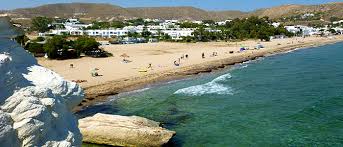
Agua Amarga
Monday 15th January
Left Agua Amarga at 9.50 a.m. turning left and following the main road across barren hillside with a few homes – eventually joining main road and turning left to Almeria (54 km) then at Venta de Probe onto N344 E15 to Almeria (45 km). Keep on the motorway Motril/Malaga skirting Almeria then passing through an industrial and greenhouse area all the way past El Ejido.
Stopped for coffee at Castell de Bano just before Castell de Faro. Be warned no petrol until Castell de Faro. Then through Calahonda – Pretty town on the sea. Continue past more and more greenhouses until Motril.
Past Solobrena which is an interesting town on hill with castle. Landscape now changes to much greener with many trees and the road meanders along mountain side past Almunecar. This is southern Spain’s most spectacular coast. The Costa Tropical where mountains rise to over 2,000 m from the shores of the Mediterranean Sea. The Phoenicians founded the first settlement called Sexi at Almunecar and the Romans built an aqueduct here. When the English writer Laurie Lee made his long trek across Spain in 1936 he described Almunecar as’ a tumbling little village fronted by a strip of grey sand which some hoped would be an attraction for tourists’ . On returning in the 1950’s he found a village still coming to terms with the Spanish Civil War which he recounts in his Novel A Rose for Winter. Now Almunecar is a holiday resort.
Continue along this coast past La Herradura, and on to Nerja a fashionable resort at the eastern extremity of the Costa del Sol lying at the foot of the beautiful mountains of the Sierra de Almijara, and perched on a cliff above a succession of sandy coves. Many holiday villas and apartments are scattered along this coast and growing. Due east of the town are the Cuevas de Nerja a series of vast caverns of considerable archaeological interest which were discovered in 1959. Wall paintings round in them are believed to be about 20,000 years old.
Continue along this spectacular mountain coast road and join the new motorway missing Malaga carrying on to Cadiz etc.
Visited our friends John & Dot Prenton in Marbella for 3 days.
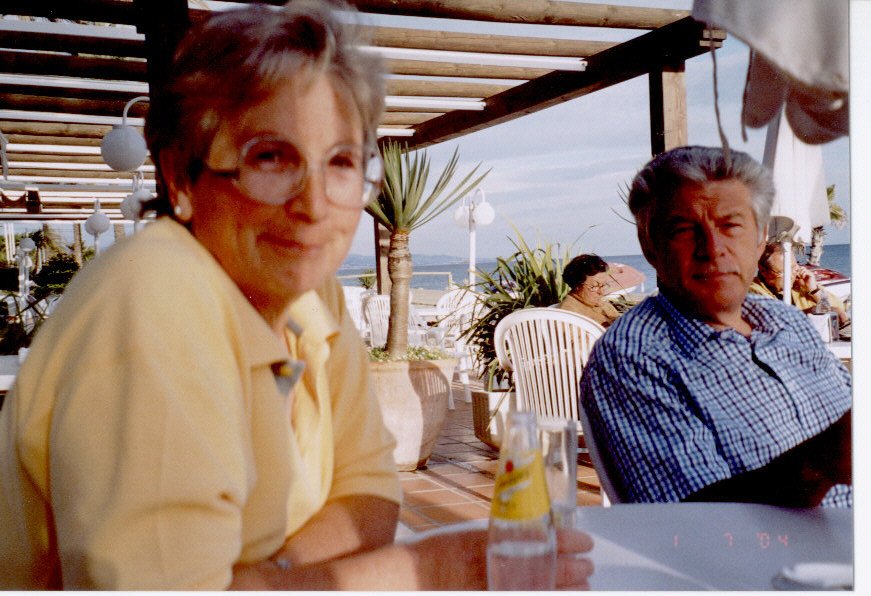
Marbella is now one of Europe’s most exclusive holiday resorts, for the International Jet Set. This can be seen by the large amount of Yachts both in Marbella and Puerto Banus, the increased numbers of Golf Clubs and holiday homes – and most importantly the increased amount of traffic!! The old town of Marbella is still worth a visit and eating outside in Plaza de los Naranjos – the main square – shaded by Orange trees. Devotees of Pablo Picasso can visit the Museo del Grabado Espanol Contemporaneo where some of his least known work is exhibited. Those who prefer nightlife should come with a full wallet.
Visited El Castillo de Monda for Coffee with Dot & John – standing majestically above the white village of Monda. This hotel has witnessed centuries of history. The town of Monda dates from before Roman times and has seen the passing of not only the Romans but also the Pheonicians. The moors fortified the site due to its strategic position which affords dominating views over the Sierra de las Nieves, one of southern Spain’s most beautiful natural parks.
Thursday 18th January
Left Marbella at 7.50 a.m. Mileage registering 824 km.(Direct route from Alicante to Marbella on the motorway is 533 km).
Headed for Malaga then onto route for Cordoba. Leaving Malaga heading inland through picturesque mountains and valleys at 8.55 a.m. came off N331 to Antequera
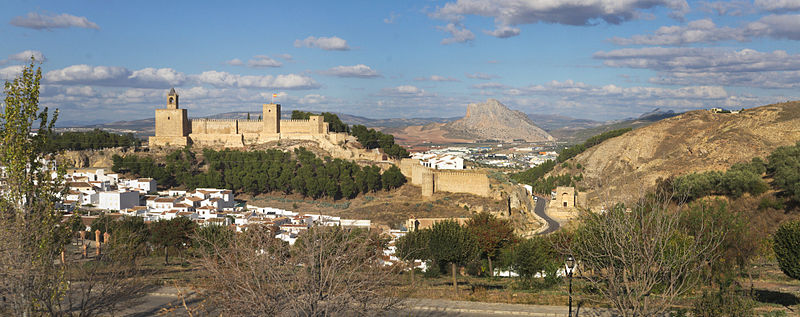
Antequera
Entered town through an industrial area. A busy market town and commercial centre in the Guadalhorce river valley. Long been strategically important,. First as Roman Anticaria and later as a Moorish border fortress defending Granada. Of Antequera’s large number of churches, one in particular, The Inglesia de Nuestra Senora del Carmen with its vast, exuberant, Baroque altarpiece is not to be missed.
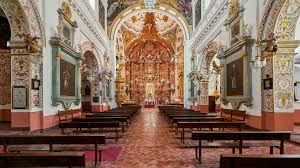
Inglesia de Nuestra Senora del Carmen
To the west of here, at the opposite end of the town, is the 19th century Plaza de Toros where there is a museum of bullfighting. High on the hill overlooking the town is the Castillo Arabe, a Moorish castle built in the 13th century on the side of a Roman Fort.
Leave Antequera and join N331 to Lucena and Cordoba across flat plains – a rather bad road surface. Then enter an area of olive groves as far as the eye can see. Pass through the village of Encino Reales onto the outskirts of Lucena where the road is inundated with furniture manufacturers and lighting manufacturers – very industrial – Past Lucena onto Aquiller N331. Open fields and flat land – few rolling hills – agricultural, arable land.
Arrived at Cordoba at 10.52 (1,053 km)
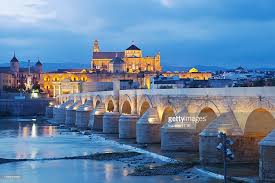
Parked at the top of Avenida del Gran Capitan on the Avenida de America in a large underground car park. From here we walked to the Mezquita area – The heart of Cordoba – the old Jewish quarter. Walking around this area gives the visitor the sensation that little has changed since this was one of the greatest cities in the western world. Narrow, cobbled streets where cars cannot penetrate, secluded niches, wrought iron gates, tiny workshops where silversmiths create fine jewellery, all appear very much as it was 1,000 years ago.
Traffic roars along the riverfront past the replica of a Moorish water wheel and the towering walls of the Great Mosque. Most of the sights are in this area, while modern city life takes place some blocks north, around the Plaza de las Tendilla. We visited the Museo Taurino where a replica of the tomb of the famous torero, Manolete and the hide of the bull that killed him are in this museum of bullfighting.
Also visited Callejon de las Flores where colourful geraniums stand out vividly against this whitewashed narrow alley leading to a tiny square (not so colourful in January)
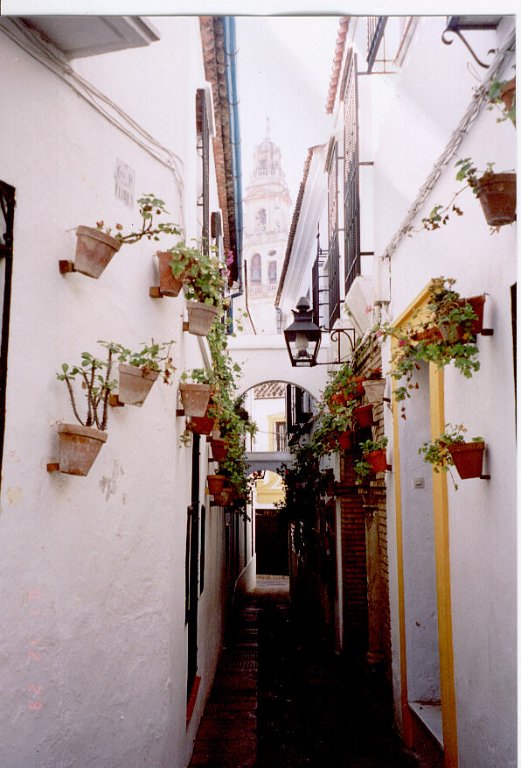
Also visited Museo Julio Romero de Torres (1874-1930) who was born in this house, and captured the soul of Cordoba in his paintings. Many depict well-proportioned nudes in stilted poses. His humour emerges in a nude study Oranges and Lemons.
Had a wonderful lunch in Taberna Salinas. We would return on another trip when we would spend more time in this wonderful city
Left Cordoba at 3.45 pm to Bailen on NIV/E5 to Madrid (another direction was Seville)
Good fast duel carriageway across rolling countryside to Bailen approx 100km. Many more millions of Olive trees!!
At Bailen take N323 to Jaen/Granada (same turnoff signposted N322 to Albacete) After about 2 mins take N322 to Linares/Ubeda/Albacete. Single line traffic but reasonable. After 5 minutes pass Linares. Then 25 km to Ubeda. We took the 2nd turnoff Ubeda North and followed centre city signs but the central square was being resurfaced. We would return to Ubeda in 2018
Mileage 1023 Discover Ubeda amidst a sea of olive trees. Once a refuge for saints and famous for its battles, today it is a peaceful city, rooted in its splendid past. Close by are the Sierras of Cazorla and Segura, as well as the village of Baeza (visited in 2018). In the heart of this legendary city is a 16th-century palace – the hotel Palacio de la Rambla where we stayed. Brochure in file.
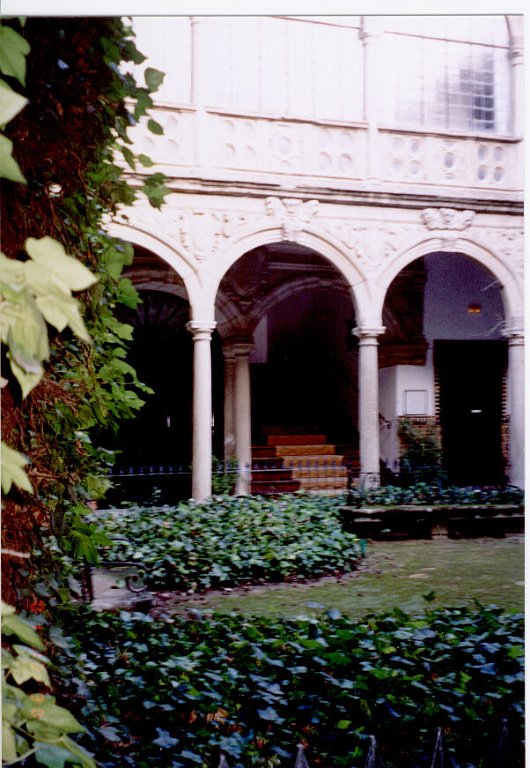
It has a beautiful renaissance cloister courtyard. But fortunately, the hotel is modern enough to have good central heating in its rooms even on a very cold evening in January! Cost of the night for two inc. breakfast 104.86 Euros. Went out for drinks and tapas to Maison Barbacoa as unfortunately, the hotel did not do dinner. Bought a large tin of Virgin Olive Oil special to the area.
Friday 16th January
Left Obeda at 12.10 on Friday N322 Albacete/Valencia. Villocarillo (32K) Not a dual carriageway but a good long road, again through masses of olive trees as far as the eye can see. Then the road changed to a very bad surface with many lorries and not too many passing places. After turning off Genave land becomes more arable and cultivated and the olive trees diminish – better quality road into Albacete Community. Turn right after Reolid onto CM412 Riopel. The road now goes through mountains on the top of which there is snow (January) Twisting mountain road but a good surface and not much traffic. Then twists along a dry river bed. Magnificent scenery Puerto de las Crucetas – Pine trees and snow. Drop down to Riopal which is set in a wider valley with mountains all around.
After sausages and bread at Riopal on to Elche de la Sierra – off here onto CM3257 signposted Caravaca.
Left Elche at 3.08 (1,413 km) Watch for CM 3217 Signposted “Socovos” soon after Ferez. Modern new resurfaced road. Left Ferez at 3.30 (1,433 km) See picture of town CM3217 now a bad road to Tazona then into Murcia Province with new tarmac road (part) onto Los Murtas on a bad road. All this road is in process of being renewed. Turn left to Calasparre, not to Moratello MU510
At Calasparra turn right to Caravaca C3314 then onto B20 to Vallentin after 15 minutes
Stayed at Molino Sahajosa in Valentin Owned by the Lopez family who has lived here for nearly 200 years. This was originally a mill and has a museum dedicated to its past including a part of country life showing the old village projector. There is a brochure in the file but it now looks as if it has been turned into a hospice – so perhaps we won’t go back voluntarily.
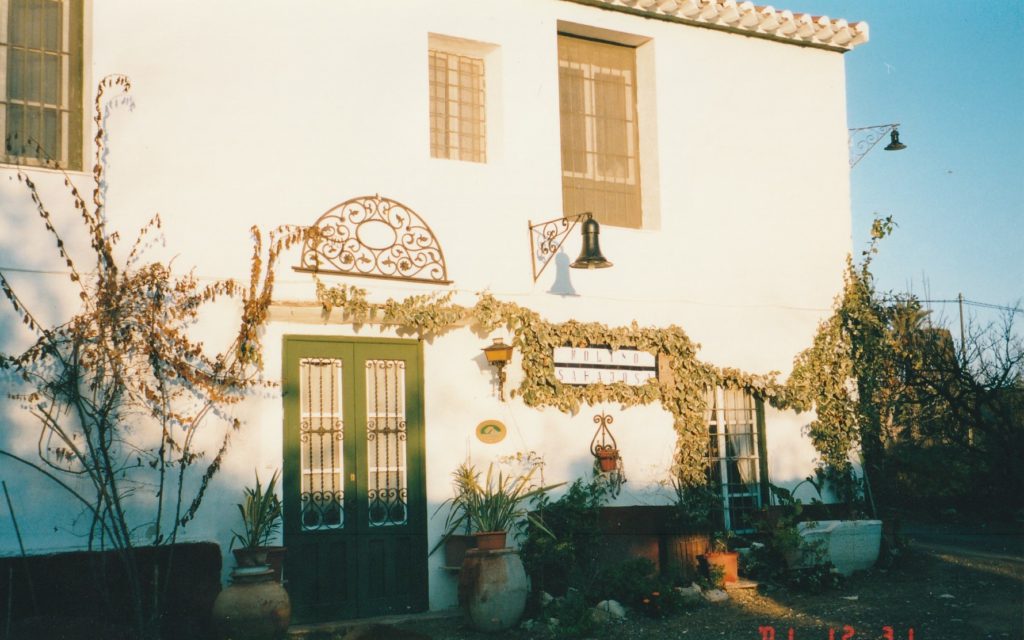
Unfortunately again because we were the only guests the recommended restaurant was closed. The bedroom was freezing but they put a log fire in the dining room for us and after visiting Valentin (Cehegin) – map in file – and having a lovely drink at the top of the old town we bought a good bottle of wine – bread cheese and ham and came back to have our picnic around the log fire, after which we jumped into a very hot bath and then quickly into bed – Sure the place must be lovely in the summer but definitely not a winter visit.
Saturday 17th January
Left Valentin at 9.15 am (1,511 km) Leaving Valentin take the road to Caravaca/Cenegin C3314 at the roundabout take C415 to Murcia (visit Caravaca if time) Fast new road then 62 km to Murcia. Follow signs to Murcia then onto N301 round outskirts of Murcia motorway the A7E15 to Alicante Murcia 10.00 am (1,600 km)
Home at 11.45 after a trip of 1,789 km